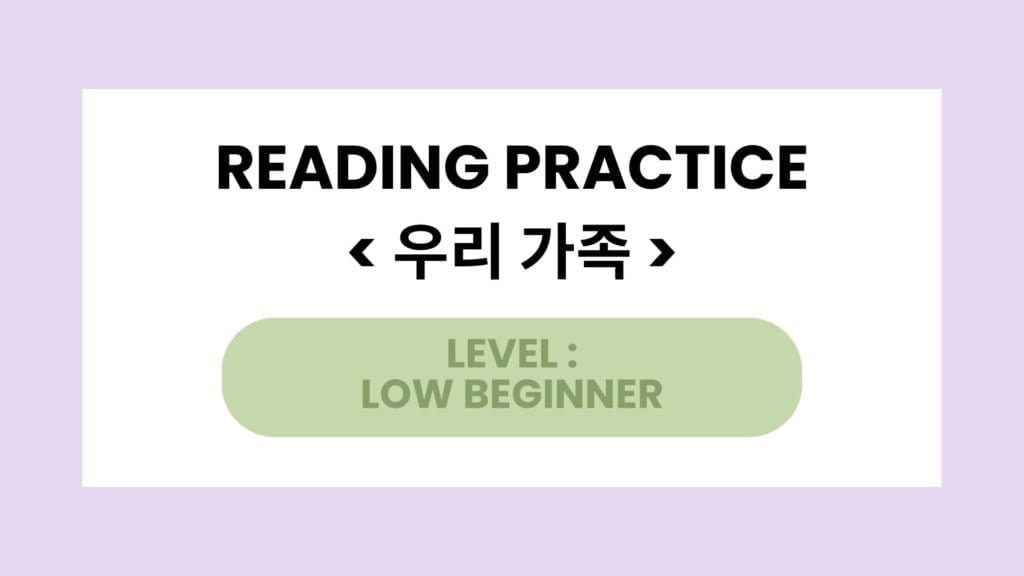안녕하세요 여러분! 🙂 I’m meeting you today with another Korean reading practice. This reading practice is aimed at beginners. It will suit you well if you’ve started learning Korean recently!
If you’re still a beginner looking for something more challenging, check out this text about classmates. It’s a little longer, and a bit more complicated.
In this article, you will find :
- A short text or story written in Korean
- A translation of the text
- A vocabulary list
- A short explanation of the most difficult grammar parts if necessary
- A few questions to review your understanding of the text
When we do not write the texts ourselves, we give credits where credits are due. Links marked with * are affiliate links, and we will earn a small commission at no extra cost to you. It will help support the blog, so thank you. 🙂
You can find this text and more in the book Yonsei 1-1*, which is a good textbook for beginners who want to pick up Korean!

Check out Yonsei 1-1 on Amazon*
Table of Contents
Korean Reading Practice

우리 가족
우리 가족은 모두 여섯 사람입니다.
저는 언니가 하나, 남동생이 한 명 있습니다.
할머니하고 부모님은 고향에 계십니다. 아버지는 선생님이십니다.
어머니는 주부이십니다. 할아버지는 안 계십니다.
남동생도 고향에 있습니다. 남동생은 고등학생입니다.
언니하고 저는 서울에 있습니다. 언니는 회사원입니다. 저는 대학생입니다.
저는 할머니를 아주 좋아합니다. 우리 할머니는 재미있으십니다.
Translation
My Family
My family consists of six people in total.
I have one older sister and one younger brother.
My grandparents and parents live in my hometown.
My father is a teacher. My mother is a housewife. My grandfather is not here.
My younger brother is also in my hometown. He is a high school student.
My sister and I are in Seoul. My sister is an office worker. I am a college student.
I really like my grandmother. My grandmother is fun.

Vocabulary
| 한국어 | 영어 |
|---|---|
| 가족 | Family |
| 여섯 | Six |
| 언니 | Older sister |
| 남동생 | Younger brother |
| 할머니 | Grandmother |
| 부모님 | Parents |
| 고향 | Hometown |
| 아버지 | Father |
| 어머니 | Mother |
| 주부 | Housewife |
| 할아버지 | Grandfather |
| 고등학생 | High school student |
| 회사원 | Office worker |
| 대학생 | University student |
| 재미있다 | Fun, interesting |
Grammar points
있다 / 계시다
있다 (it-da) and 계시다 (gye-si-da) both translate the idea of “to exist” or “to be”, but their usage is different.
있다 is the more commonly used one. It’s straightforward and used in everyday situations. You’d use it when talking about the existence of something or someone in a general sense. For example, if you’re asking if someone has a pen, you’d say “펜이 있어요?”, which translates to “Do you have a pen?”
On the other hand, 계시다 is more formal and respectful (we call it the honorific form). You’d use it when talking about someone you want to show respect towards, like elders, guests, or someone of higher status. It’s often used in honorific speech. For instance, instead of saying “엄마가 있어요?”, which means “Is mom here?”, you’d say “어머니께서 계세요?”, which translates to “Is mother here?”, in a more respectful tone.
So, in a nutshell, “있다” is more casual and general, while “계시다” is more formal and respectful, especially when referring to others. Remembering when to use each one will help you speak Korean more naturally and respectfully in different situations!
Questions : About the Text
(1) Choose the right answer
① 언니 – 회사원
② 아버지 – 은행원
③ 남동생 – 대학생
④ 어머니 – 선생님
(2) True or false ?
① 우리 가족은 모두 같이 삽니다.
② 할아버지하고 할머니 그리고 부모님은 고향에 계십니다.
③ 저는 여자입니다.
④ 언니는 서울에서 일합니다.
Answers
First question :
① 언니 – 회사원
Second question :
① 우리 가족은 모두 같이 삽니다. => False
② 할아버지하고 할머니 그리고 부모님은 고향에 계십니다. => False
③ 저는 여자입니다. => True
④ 언니는 서울에서 일합니다. => True
Check out Yonsei 1-1 on Amazon*

Study Method for Texts
If you’re not familiar with text study, here’s a method I would suggest you try.
To study this text, start by reading it from beginning to end once without paying too much attention to whether you understand fully or not. Then, listen to the audio file (if there is one) and read along.
You can press pause as many times as needed.
During your second read, try to understand as much as possible. If you can’t understand some of the words, check their meaning as well.
When you finish your second read, ensure you understood the story/text correctly. Read a third time (with or without audio). It’s even better if you read it out loud: it will improve your speech fluency over time.
You can then try answering the questions asked at the end!





I loved it
I’m glad you did! I’ll be making more of these:)